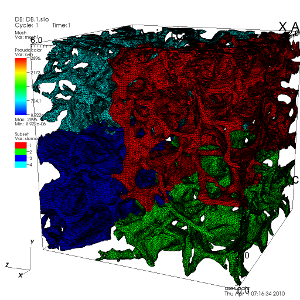 Description
Description
For many applications such as the simulation of human bones, a volume mesh is constructed out of a hull mesh. Due to the high complexity of the geometry such as for example on the picture provided to the right, it is of advantage to decompose the hull mesh into smaller segments. Such a decomposition is indicated by the coloring in the figure. Volume meshes are then created in a parallel, distributed manner. The student should provide a C++ interface for a hull mesh decomposition based on simple geometric rules. The decomposed hull mesh then serves as input for a distributed parallel meshing engine as described in the idea "ViennaMesh: Distributed Parallel Meshing of Segments"
Benefit for the Student
The student will gain profund knowledge about hull meshes and learn to design a unified interface. Insight into the key aspects of distributed meshing will be gained.
Benefit for the Project
While a single hull mesh allows for a single volume mesher instance, properly decomposed hull meshes can be run on large computing clusters with hundreds of volume mesher instances in parallel. ViennaMesh will become a valuable tool for large-scale simulations with millions to billions of unknowns.
Requirements
Good C++ skills are required accompanied by some basic experience in generic programming, like Tag-Dispatching. Familiarity with the basic principles of mesh generation is of advantage.